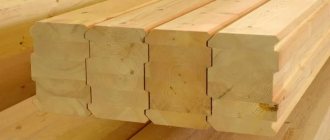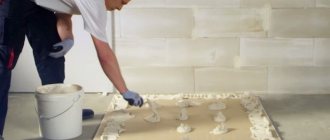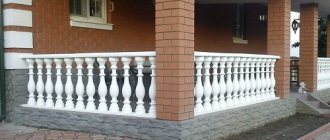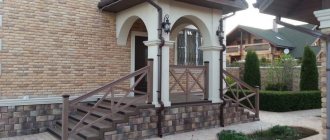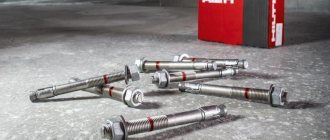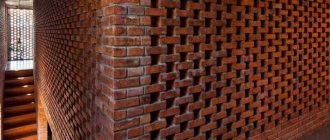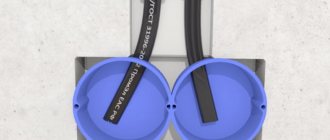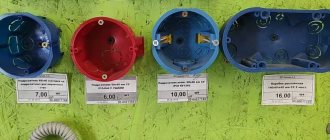Wall-mounted sockets are more popular than overhead sockets. Their undeniable advantage is their compactness and the absence of surfaces for collecting dust. They are reliable in terms of resistance to mechanical stress. Their most important advantage is the hidden wiring, which eliminates the creation of obstacles when finishing the interior. To get all these benefits, you must first figure out how to install a socket in the wall . You can do this yourself, even if you have to install a socket box and lay wires. Connecting sockets is much easier than installing light switches.
Connecting the socket in the installation box
Briefly about the types of built-in sockets
The technical parameters of the outlet must fully comply with the requirements of the connected consumer. You need to look at the power of the devices that will be powered by it. The maximum permissible current in Amperes is indicated on the housing of the sockets and in their instructions. The power of the connected electrical equipment is measured in kW. These values can be compared using the table.
Table 1. Correlation of socket power to consumer parameters and required wiring cross-section.
| Outlet current A | Consumer power kW | Wire cross-section mm2 | |
| Aluminum | Copper | ||
| 6 | 1.3 | 2.5 | 1 |
| 10 | 2.2 | 2.5 | 1.5 |
| 16 | 3.5 | 2.5 | 1.5 |
| 32 | 7 | 10 | 6 |
All built-in sockets that may be needed for installation in an apartment or private house can be divided into 3 groups:
- ordinary;
- waterproof;
- power.
Conventional sockets are used to power the vast majority of electrical appliances. You can connect a mobile phone charger, computer, router, hair dryer, refrigerator, microwave oven, etc. to them.
Regular socket
Waterproof sockets are used for installation in wet areas, usually in bathrooms. They can be distinguished from ordinary ones by the presence of a lid covering the socket for connecting the plug. It provides splash protection. Such an outlet will be required if the installation is carried out in close proximity to a sink, shower or bathtub. For this purpose, devices with protection class IP44 and higher . This will reduce the likelihood of electric shock even in the event of flooding, which is accompanied by water leaks along the walls. If the installation is carried out in a large bathroom of a private house far from water sources, then you can get by with a regular outlet.
Waterproof socket in the bathroom
Prices for waterproof sockets
Waterproof socket
Power sockets used in houses and apartments usually have the same plug standard, but have a higher power rating. Their indicator for this parameter is 32A and above . They are used to connect devices with high electricity consumption. First of all, this is an electric stove, electric oven, air conditioner, fireplace or boiler. Sometimes power outlets may have a triple socket. Their choice depends solely on the plug with which the electrical appliance is equipped.
Power socket
Prices for power sockets
Power socket
Preparing the solution
Since it is necessary to quickly fix the socket in a concrete wall, gypsum or alabaster-based mixtures are used for fastening. A pure gypsum solution hardens in 3-5 minutes, which requires constant mixing of small portions of the mixture and regular cleaning of the container from the hardened material.
To increase the shelf life of the solution, use a mixture consisting of 3 parts gypsum and 2 parts Knauf Rotband gypsum plaster or equivalent. It is not recommended to use pure plaster due to the reduced mechanical strength of the hardened material.
The solution is mixed in a 3-4 liter container made of elastic material. To dissolve the powder in water, use a mixer clamped in the chuck of a drill or hammer drill (in non-stress mode). Before mixing the batch mixtures, the container is cleared of any remaining solidified solution.
Precautionary measures
Since there is a possibility of electric shock when performing work, it is necessary to turn off the power to the apartment or house during electrical installation. This can be done using switches in the electrical panel. If the room has old-type wiring, you can turn off the power supply by unscrewing the plugs on the meter. Work on installing a socket box, when contact with live wires is excluded, is carried out without turning off the power, to allow the use of auxiliary power tools.
Attention! Before proceeding directly with electrical installation, you should make sure that the wires are actually de-energized. The check is carried out with an indicator screwdriver or tester.
Checking for voltage
Prices for voltage measuring instruments
Voltmeter
Socket height standards
Initially, you need to decide where exactly and at what height the outlet will be installed. There are so-called European and Soviet standards. According to the first, installation is carried out at a height of 30 cm from the floor. The Soviet standard provides for a level of 90 cm .
Eurostandard
You don't always need to be tied to the requirements, as there are cases where this option is not suitable. First of all, the need to install a socket at a different height arises in the bedroom, in particular when installed above a bedside table. It is placed in such a way that you can reach it while lying down, for example, to charge a mobile phone. It is convenient for the socket to be at a height of 65-70 cm .
Installation option above the bedside table
The location of outlets in the kitchen deserves special attention. Downward installation is excluded since they will be covered by furniture. They are mounted in any order, usually trying to be placed immediately above the countertop or under the bottom of the upper cabinets. In the latter case, they are invisible at a glance, but are always accessible.
Placement above the kitchen countertop
Selecting a Receptacle-Compatible Mounting Box
Built-in sockets are fixed in a special installation box, the so-called socket box. It is a thin-walled cylinder that is walled into the wall. In the future, the socket is attached to it, and not to loose masonry material or concrete, which would be unreliable.
Advice! It is better to buy the installation box at the same time as the socket, which will ensure their full compatibility.
Sockets from individual manufacturers provide different methods of attachment to the socket box. First of all, this concerns the location of the screws. They can be located along a vertical or horizontal axis. Some devices have 4 mounts at once. The diameter of the installation boxes is 65-67 mm . Depth 45 mm . They can be made of polyamide, polypropylene and other materials.
Regular socket box
Attention should be paid to the selection of the installation box for the socket block. The fact is that almost every manufacturer produces its products to different width standards. That is, the distance between the sockets, including the overhead panels, differs so much that it will not always be possible to install it in an installation box of another brand.
Attention! If fastening is required in ordinary walls, classic cylindrical socket boxes are used. For installation in plasterboard, special installation boxes are produced with special screws and ears for attaching to the sheet.
Socket box for drywall
Installation of a socket box
After purchasing materials, you can outline the installation location. The technology used for installation differs depending on the type of wall. Working with concrete, aerated concrete and brick is almost identical, but working with drywall is different. Differences are also observed in the set of tools that are required.
Installing a socket box in concrete, aerated concrete or brick
Working with such wall materials requires specialized tools. You will need to prepare:
- perforator;
- core drill 68 mm;
- chisel or pick for a hammer drill.
Core drill
Prices for socket drills (core drill)
Core drill
First you need to make a mounting hole in the wall to install the socket box using a special core drill. It is installed on a drill or hammer drill. Crowns come in different price segments and differ in cutting edge material. They come in diamond and carbide. Drills also differ in operating mode. Some are used only with a drill, while others are impact, so they are suitable for drilling with chiselling included.
Recommendation! When purchasing a core drill, you need to consider not only its diameter, but also the type of shank. For doors it should be cylindrical, and for a hammer drill sds-plus or another. Otherwise, the incompatible crown will not fit the existing instrument.
If you need to drill reinforced concrete, you will need to use a more expensive diamond-coated bit on the segments, since cheap equipment breaks. You also need to set the optimal number of revolutions recommended in the instructions for the drill.
There is a concrete drill in the center of the cylindrical crown. It is used for alignment. The protruding drill is placed in the center of the future socket box and deepened into the wall until the ring begins to be drilled with a crown. After this, you need to stop drilling and remove the alignment. This will prevent the protruding part of the tool from making a through hole. The centering drill is removed by knocking it out with a wedge or unscrewing a special clamping bolt.
Drilling into the wall
If you need to install a block of sockets, then you need to look at their instructions, as well as the parameters of the socket boxes and determine the center distance. Usually it is 71 mm . To make everything smooth, ideally, immediately after removing the crown to remove the centering drill, you need to make markings from the small hole along a horizontal line in increments of 71 mm . The resulting points will be used in the future to center subsequent drillings.
Marking for a block
After drilling, a circular hole will remain. All that remains is to knock out its central part. This can be done conveniently using a hammer drill with a lance. You can get by with an ordinary hand chisel and hammer. You need to insert the tool into a narrow strip of a larger drilled circle and strike. As a result, the central part will fall out. When working with aerated concrete or brick, this is not difficult. It will be more difficult to knock out concrete if it is reinforced with steel reinforcement.
Installation sequence
Having a hole ready, you can cut a groove in the wall to the ceiling, where the junction box is located, in order to make a branch of the power cable. To compensate for the error, the laid cable is taken 30-40 cm . In the future, the excess can be cut off. When moving on to laying the cable and connecting to the junction box, you will need to turn off the power to the room.
Junction box
After preparing the groove and the hole itself for the socket box, you need to insert the installation box into it and check the depth so that nothing sticks out. Next, you should prepare a thick mortar. It is most convenient to use alabaster and gypsum plaster.
To insert the power wire into the box, you need to break out the window using pliers or cut it off with a knife. In such places, manufacturers make the plastic thinner to allow mechanical extrusion. Next, you need to place a little solution deep into the hole, and then insert the box with the wire inserted into it.
Gluing socket boxes
The socket box should be leveled using a level. If it has only two vertical or horizontal fasteners, then their orientation must be selected depending on the characteristics of the purchased outlet. If there are 4 fasteners, this does not matter.
Socket box with two fastenings
The side cavity between the box and the wall is also filled with solution. If alabaster was used, then after 3-4 hours the installation box will sit securely. You should wait until the solution is completely dry and stops evaporating. Under no circumstances should foam be used to secure the socket boxes, as it is a flammable material.
Advice! If you need to install one or more sockets, then it is not advisable to buy an expensive crown. Holes can be cut with a grinder. In this case, the amount of dust from the work increases. Although accuracy suffers, everything will then be covered with plaster. To cut with a grinder you will need a diamond wheel.
Work as an angle grinder
Prices for popular models of wall chasers
Wall chaser
Video - Installation of socket boxes in a concrete/brick/aerated concrete wall
Preparatory work
Socket in the wall with one socket
Before making a hole for the socket in concrete, it is necessary to draw up a diagram and carry out calculations. Cables may only be laid in vertical and horizontal directions, any diagonals are excluded. If grooves are made, the wire must be pulled into a corrugated plastic tube, which is embedded in the groove.
Based on the drawn up diagram, materials, tools and accessories are calculated. In addition, it is necessary to consider security issues.
To install internal sockets yourself, you will need the following tools:
- hammer drill, grinder;
- level, tape measure;
- pliers, wire cutters, knife, hammer, chisel;
- drill for sockets, diamond bit, set of screwdrivers;
- indicator;
- narrow spatula, thin paint brush;
- corrugated plastic tube;
- pencil.
Standard appearance of socket boxes
The following materials must be purchased:
- three-core copper cable so that grounding can be done;
- plastic socket boxes;
- plaster or putty;
- liquid primer for concrete and plaster;
- sockets with three contacts.
To make work easier, you should have a stepladder or a stable table to work at heights. You need to protect your vision and respiratory organs with a respirator and construction glasses. Installation should be carried out with gloves.
Installation of socket boxes in drywall
To work with drywall, you will need a special type of mounting box with a special claw, which will allow you to press it to the sheet like a vice or clamp. To carry out installation, you need to drill a hole. This can be done with a special core drill for drywall. You can cut a circle with a mounting knife. Since the wires are hidden behind the drywall, no gating is required. The embedded cable should be pulled out into the resulting hole and inserted into the broken window of the socket box. You need to insert the mounting box into the wall and tighten the screws, retracting the clamping tab.
Fastening the socket box in plasterboard
Connecting the socket
Direct connection of the socket when installing in drywall is carried out immediately. If the mounting box is secured with mortar, you will have to wait 2-3 days . The sequence of further actions is as follows:
- shortening the protruding cable;
- stripping the ends of conductive wires;
- screwing the wires to the socket terminals;
- installation of an outlet;
- fixing the decorative frame.
The tail of the wire protruding from the socket is too long, so it will need to be trimmed. It is necessary to leave such a length that when folded it can be hidden in the remaining space of the box. The ends of the wires are cleared of insulation. In the absence of a special tool, this can be done with a mounting knife, being careful not to damage the conductor. The instructions for the socket recommend stripping the clay to 10-15 mm .
Wire stripping degree
To properly connect the wires to the socket terminals, you need to separate the grounding conductor, if any. Phase and neutral have single-color insulation, and grounding has two-color insulation. The supply wires are connected to the side terminals. Grounding goes in the center.
Electrical installation
The next step is to carefully fold the wires to place the socket in the installation box. Next, using a screwdriver, you need to screw it to the socket box using screws. Fixing with spacer pads is also possible. They are located on the sides of the socket. The more you twist them, the wider they move apart and provide rigidity of fixation.
Attaching to a socket box
After securing the socket, you need to snap its frame. If it is not there, then screw on the cover panel. It is held in place by one screw, centered between the plug holes.
Video - DIY socket installation
Subtleties of connecting the socket block
When connecting a double, triple or block of sockets, a parallel connection will be required. To do this, small pieces of wires measuring 15 cm . Their ends are stripped of insulation. Such segments are used to connect socket terminals. On sale you can find special blocks immediately connected to each other.
Block connection
Marking
The center of the future outlet is marked as a marking on the concrete plane. If a block consisting of several sockets is mounted, then the center of each element is marked.
To maintain the evenness of the marking axis, it is better to use a ruler or a flat level, and then mark the center point of each socket. In this case, the center of the first rosette is marked and the standard center distance (7.1 cm) is marked from it.
What to do with aluminum wiring
In older houses, all wiring is made of aluminum. Often such wires break off, so when you try to insert a new socket into an existing socket in the wall, you cannot connect. In this case, you will need to extend the wire. The use of ordinary twisting is unacceptable. To get out of the situation, you can use special glued pads. This will make it possible to build with copper wires, which eliminates oxidation between two different metals. By adding a couple of wires of 10-15 cm , you can connect an outlet.
Wire extension
Installation of power sockets for powerful consumers
If there is a need to power a powerful electric stove, oven or other equipment, then you need not only to choose a power outlet, but also a large cross-section cable. Its throughput must correspond to the consumption parameter of the electrical appliance. The wire for such equipment should not have twists in its path. It is not connected to the junction boxes, but is led directly to the electrical panel. This is a mandatory fire safety rule.
Construction and components
To thoroughly understand how to properly install a new outlet at home, you need to study a little about its components. All sockets are sold already assembled. Therefore, when installing it, you will have to unscrew everything yourself.
The main components of the socket are the base, the conductive part, and the decorative front panel. The base is made of ceramic or high-quality plastic. All elements are attached to it - conductive parts and the front cover.
Ceramic bases are considered more reliable, but they require particularly careful installation, because if damaged, you will have to buy a new socket.
The decorative overlay is designed to hide all working elements. It serves as a reliable insulator of the working part from external influences. Some models provide the ability to simply replace this part of the outlet.
Getting to know the internal structure of the outlet will help you better understand the process of connecting it correctly.
The working part of the socket consists of spring contacts and terminals to which electrical wires are connected. One of the important contacts is the grounding one.
The conductive elements are made of brass or bronze. The latter are better, but are extremely rare. Therefore, you should choose options made from tinned brass - they are more reliable than conventional brass, are better soldered and last longer.
Designer sockets allow you to make the interior of your home unforgettable. Their unusual performance adds its own flavor
